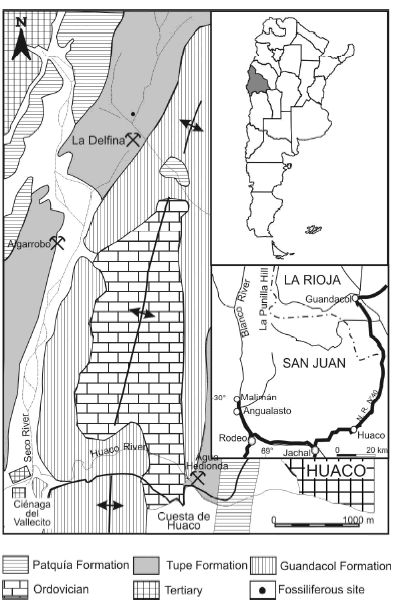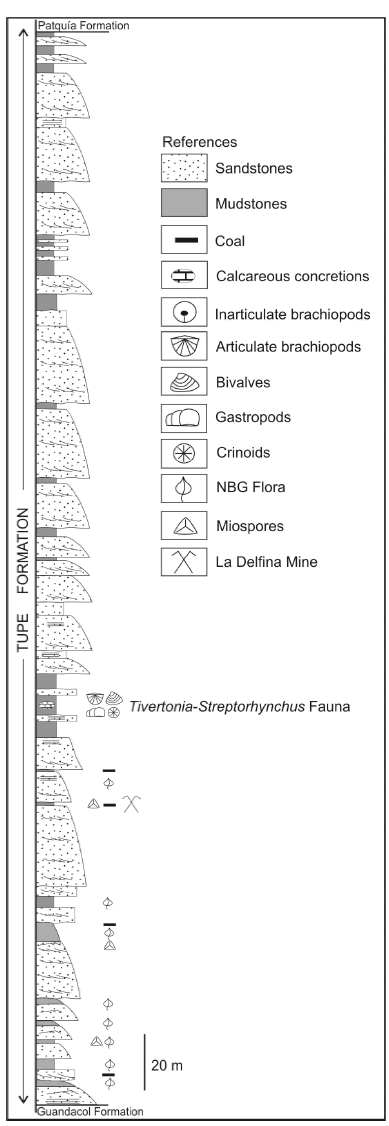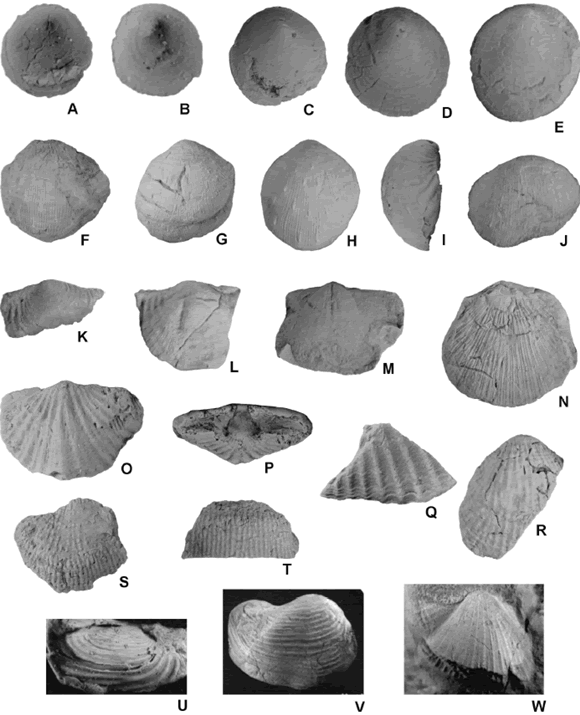Servicios Personalizados
Revista
Articulo
Indicadores
-
 Citado por SciELO
Citado por SciELO
Links relacionados
-
 Similares en
SciELO
Similares en
SciELO
Compartir
Ameghiniana
versión On-line ISSN 1851-8044
Ameghiniana v.43 n.2 Buenos Aires abr./jun. 2006
A review of the Tivertonia jachalensis-Streptorhynchus inaequiornatus Biozone in La Delfina Creek, San Juan Province, Argentina
Gabriela A. Cisterna1, Andrea F. Sterren2 and Neil W. Archbold3
1 CONICET. Universidad Nacional del Comahue, Museo de Geología y Paleontología, Buenos Aires 1400, 8300 Neuquén. gcisterna@yahoo.com.ar
2 CONICET-CIPAL, Facultad de Ciencias Exactas, Físicas y Naturales, Universidad Nacional de Córdoba, Avenida Vélez Sarsfield 299, 5000 Córdoba, Argentina. asterren@com.uncor.edu
3 School of Ecology and Environment, Melbourne Campus, Deakin University, Burwood Victoria, 3125, Australia. narchie@deakin.edu.au
Introduction
The Tivertonia jachalensis-Streptorhynchus inaequiornatus Biozone was originally named the Lissochonetes jachalensis-Streptorhynchus inaequiornatus Biozone by Sabattini et al. (1990) and it was referred to the Late Carboniferous. Also, other authors (Taboada, 1997, 1999; González, 1997) suggested a late Carboniferous (Stephanian) age for this biozone. Archangelsky et al. (1996), considering the Permian age of the genus Tivertonia, proposed that this biozone would be extended to the Permian. Recent studies of the brachiopods as well as palynological data from the stratigraphical section of the Tupe Formation (Cuerda, 1965) at La Herradura Creek (San Juan Province, Paganzo Basin), have suggested an earliest Permian age for the biozone stratotype. This biozone has also been identified in the Río Blanco Basin where it appears in the middle member of the Río del Peñón Formation (Borrello, 1955; González and Bossi, 1986) at the Rincón Blanco locality, La Rioja province (Cisterna and Sabattini, 1998; Cisterna and Simanauskas, 1999, 2000). The stratigraphical sections of the Río del Peñón and the La Delfina Creek were also proposed as para-stratotypes of the Tivertonia jachalensis-Streptorhynchus inaequiornatus Biozone (Sabattini et al., 1990).
Outcrops of the Tupe Formation at La Delfina Creek are located on the west flank of the Perico hill, about 29 km northeast of Jachal, San Juan Province, Paganzo Basin (figure 1). Ottone and Azcuy (1986) studied this stratigraphical section and identified a marine fossiliferous interval in the middle part of the section. These authors recognized brachiopods ("Lissochonetes" jachalensis (Leanza) and Septosyringothyris sp.), gastropods (?Peruvispira sp. and "Neilsonia" sp.) and crinoids. Sabattini et al. (1990) redescribed the gastropods identified by Ottone and Azcuy (1986) and assigned this material to Mourlonia sanjuanensis Sabattini, Ottone and Azcuy and Barrealispira tupensis Sabattini, Ottone and Azcuy.

Figure 1. Location map of the Tupe Formation at La Delfina Creek / mapa de ubicación de la Formación Tupe en la quebrada de La Delfina. Modified from / modificado de Ottone and Azcuy (1986).
Palaeogeographically, these outcrops belong to the precordillerian part or western sector of the Paganzo Basin (the "Guandacol embayment" of López Gamundí et al., 1994). The marine horizon of the Tupe Formation in the La Delfina locality represents the easternmost point of the Panthalassan marine ingression into the western Paganzo Basin. Hence, the La Delfina fauna is comparatively impoverished in relation with those registered in other localities inside of the western part of the Paganzo Basin, such as La Herradura Creek.
Field work in the La Delfina Creek (G.A.C.) resulted in a new collection of marine invertebrates that provides new records of brachiopods and bivalves from the Tivertonia jachalensis-Streptorhynchus inaequiornatus Biozone in this locality. This review also provides new data on the biostratigraphical and palaeogeographical implications of this fauna.
Repository. The fossils figured in this paper are registered by the prefix IPI (Instituto de Paleontología, sección Invertebrados), housed in the collections of the Miguel Lillo Foundation (San Miguel de Tucumán, Argentina) and by the prefix CEGH-UNC housed in the collections of the Centro de Investigaciones Paleobiológicas (CIPAL), Facultad de Ciencias Exactas, Físicas y Naturales, Universidad Nacional de Córdoba.
Stratigraphical distribution and faunal composition
The lower section of the Tupe Formation at La Delfina Creek has been interpreted as a deltaic, swamps system containing a high proportion of organic matter. The fossiliferous interval studied herein represents a short marine ingression in which the lithological and fossiliferous aspects suggest a shallow marine environment. To the upper part of the Tupe Formation at La Delfina Creek, fluvial conditions accompanied by gradual seasonal climate have been recognized (Ottone and Azcuy, 1986).
The brachiopods and bivalves studied herein are associated with a coquinoid claystone facies in a stratigraphical interval about 20 meters thick. This interval is composed of alternating sandstones and claystones with mudstones lens (figure 2). The fauna that appears in this interval is fragmentary and not abundant and it is chiefly composed of brachiopods, bivalves, gastropods and scarce crinoids. The brachiopod fauna is constituted by Costatumulus sp., Orbiculoidea sp., Trigonotreta pericoensis (Leanza), Kochiproductus sp., Streptorhynchus inaequiornatus Leanza, Septosyringothyris sp. and scarce Tivertonia jachalensis (Amos). The dominant elements in the fauna are Costatumulus sp. and Orbiculoidea sp. The bivalve fauna recognized is constituted by Heteropecten? sp., Myofossa sp., Sanguinolites? sp. and Anomalodesmata ind. (figure 3).

Figure 2. Stratigraphic section of the Tupe Formation at La Delfina Creek / perfil estratigráfico de la Formación Tupe en la quebrada de La Delfina. Modified from / modificado de Ottone and Azcuy (1986).

Figure 3. A-E. Orbiculoidea sp. A, external mould of dorsal valve / molde externo de valva dorsal IPI 3693, x5; B, external mould of dorsal valve / molde externo de valva dorsal IPI 3692, x5; C, dorsal valve / valva dorsal IPI 3691, x3; D, dorsal valve / valva dorsal IPI 3690, x4; E, dorsal valve /valva dorsal IPI 3689, x5; F-L, Costatumulus sp. F, internal mould of ventral valve / molde interno de valva ventral, IPI 3685, x2; G, internal mould of ventral valve / molde interno de valva ventral IPI 3681, x2; H, I, internal mould of ventral valve, ventral and lateral views / molde interno de valva ventral, vistas ventral y lateral, IPI 3680, x2; J, internal mould of ventral valve / molde interno de valva ventral, IPI 3682, x2; K, external mould of dorsal valve / molde externo de valva dorsal, IPI 3683, x1,5; L, external mould of dorsal valve / molde externo de valva dorsal IPI 3684, x2; M. Tivertonia jachalensis (Amos). Internal mould of ventral valve / molde interno de valva ventral, IPI 3686, x2; N, Streptorhynchus inaequiornatus Leanza. Internal mould of dorsal valve / molde interno de valva dorsal IPI 3688, x2; O-P, Trigonotreta pericoensis (Leanza). Internal mould of articulated specimen, ventral and posterior views / molde interno de especimen articulado, vistas ventral y posterior IPI 3676, x1.5; Q, Septosyringothyris sp. Fragmentary external mould / molde externo fragmentario IPI 3687, x2; R-T, Kochiproductus sp. R, Incomplete internal mould of ventral valve / molde interno incompleto de valva ventral IPI 3679, x2; S, Incomplete external mould of dorsal valve / molde externo incompleto de valva dorsal IPI 3677, x1; T, Incomplete internal mould of ventral valve, anterior view / molde interno incompleto de valva ventral, vista anterior IPI 3678, x1; U, Sanguinolites? sp. internal mould of right valve, latex / molde externo en caucho de valva derecha CEGH-UNC 21703, x 2,5; V, Myofossa sp.; composite mould of right valve / molde compuesto de valva derecha CEGH-UNC 21702, x 1; W, Heteropecten ? sp.; composite mould of left valve / molde compuesto de valva izquierda CEGH-UNC 21701, x 3.
Biostratigraphical and palaeogeographical implications
The comparison of the brachiopods from La Delfina Creek with those described from the Tivertonia jachalensis-Streptorhynchus inaequiornatus Biozone type locality (La Herradura Creek), suggests that some of the species that occur in the La Delfina Creek (Costatumulus sp., Trigonotreta pericoensis (Leanza) and Kochiproductus sp.) have been identified in the lower horizon of the fossiliferous interval from La Herradura Creek (horizon 1, see Cisterna et al., 2002a).
Among the genera recognized in La Delfina Creek, Costatumulus Waterhouse and Trigonotreta Koenig, are characteristic of the classical Permian gondwanan sequences of Australia and India. Trigonotreta, also well known from other peripheral Gondwanan regions (see Cisterna et al., 2002b), has been described in association with different species from the Río Blanco and Calingasta-Uspallata basins within the precordilleran geological province and hence it is an important element in biostratigraphical correlations (Cisterna and Simanauskas, 2000; Cisterna et al., 2000b). Trigonotreta pericoensis (Leanza) from the Tivertonia jachalensis-Streptorhynchus inaequiornatus Biozone can be compared with the Early Tastubian eastern Australian species Trigonotreta victoriae Archbold, with the Indian Trigonotreta hesdoensis (Sahni and Dutt) and Trigonotreta narsarhensis (Reed) from the Asselian and Tastubian of Peninsular India.
Costatumulus is a conspicuous element from the early Permian sequences of the Precordillera, where it has been also identified with different species in the Río Blanco and Calingasta-Uspallata basins (Cisterna and Simanauskas, 2000; Taboada, 1998). In the Río del Peñón Formation (Río Blanco basin), Costatumulus appears in three brachiopod assemblages (Cisterna and Simanauskas, 2000), e.g. Assemblage I consisting of Streptorhynchus? sp., Dyschrestia? sp. (probably equivalent to Etherilosia sp.), Costatumulus sp. A, Trigonotreta sp. and Orbiculoidea sp.; Assemblage II distinguished by Tivertonia jachalensis-Streptorhynchus inaequiornatus Biozone and the youngest assemblage III characterized by Neochonetes pegnonensis Cisterna and Simanauskas, Rhynchopora sp. and Costatumulus sp. C. In the Calingasta-Uspallata Basin Costatumulus occurs in the Costatumulus amosi (Amos) Biozone, identified in the Santa Elena (Yrigoyen, 1967) and Agua del Jagüel (Amos and Rolleri, 1965) formations (Taboada, 1998). It also occurs in the lower member of Del Salto Formation (Quartino et al., 1971) where it appears associated with Septosyringothyris Vandercammen, Tivertonia Archbold and probably Ethe rilosia Archbold (Simanauskas, pers. comm.) which is being still under study.
The genus Kochiproductus Dunbar has been recorded in the Río del Peñón Formation as the species Kochiproductus riojanus (Leanza), from beds containing the Tivertonia jachalensis-Streptorhynchus inaequiornatus fauna (Cisterna and Simanauskas, 2000) and recently from the Tupe Formation in La Herradura Creek (Cisterna et al., 2000a). Although fragmentary, Kochiproductus sp. identified in La Delfina Creek appears to be similar to species previously described.
Tivertonia jachalensis (Amos) and Streptorhynchus inaequiornatus Leanza, the species that define the biozone studied herein, are comparable to species from the Permian sequences of Australia. Hence, Streptorhynchus inaequiornatus can be compared with the Permian species Streptorhynchus hoskingae Thomas and Streptorhynchus luluigui Hosking from west Australia (Thomas, 1958) while Tivertonia jachalensis is close to Tivertonia yarrolensis (Maxwell) from the early Permian of east Australia (Archbold, 1982).
Tivertonia jachalensis (Amos) was considered to be the more conspicuous element of the Tivertonia jachalensis-Streptorhynchus inaequiornatus fauna described from La Delfina Creek (Sabattini et al., 1990). However, the new fossil collections suggest that Tivertonia jachalensis and Streptorhynchus inaequiornatus are uncommon at La Delfina Creek and that the association is dominated by Costatumulus and Orbiculoidea. On the other hand, as we noted above, the fossiliferous assemblage from La Delfina Creek is compositionally comparable to the faunal association from the lowest marine horizon of La Herradura Creek.
Considering the bivalve faunas, in the type locality (La Herradura Creek) of the Tivertonia jachalensis- Streptorhynchus inaequiornatus Biozone Nuculavus levatiformis (Walcott), Phestia sp. aff. P. bellistriata (Stevens), Modiolus (Modiolus) sp., Septimyalina sp., Palaeolima retifera (Shumard), Aviculopecten sp., Streblochondria sp., Schizodus sp., and Pleurophorella? sp. have been identified by Sterren (2004). However, this fauna is not registered yet in La Delfina Creek. In this sense, it is important to note that the bivalve faunas belonging to a same biozone in the Late Palaeozoic basins of Precordillera usually show important compositional/taphonomic changes because of environmental variations, e.g. the bivalves of the "Levipustula fauna" from La Capilla Formation in Las Cambachas and Las Juntas sections (Sterren, 2005).
Discussion
Considering the above remarks, we can suggest two scenarios: does the fossiliferous interval from La Delfina Creek represent the oldest part of the Tivertonia jachalensis-Streptorchynchus inaequiornatus Biozone of the Paganzo Basin? or is the fauna represented being controlled by local environmental factors? Future studies addressing the problems of other areas in the same basin, such as Los Azules and Paslean areas, will allow us to have a more complete analysis of trans basinal changes and possible biostratigraphical subdivisions of this biozone.
Acknowledgements
The authors wish to thank to CONICET (Consejo Nacional de Investigaciones Científicas y Técnicas) and Agencia Nacional de Promoción Científica y Tecnológica (PICT 11917). This paper is a contribution to IGCP Project 471 ("Evolución del Gondwana occidental durante el Paleozoico Tardío: registro tectosedimentario, paleoclimas y cambios biológicos"). We are also grateful to the reviewers A. Pagani and C.R. González for their helpful comments.
References
Amos, A.J. and Rolleri, E.O. 1965. El Carbonífero medio en el Valle Calingasta-Uspallata (San Juan-Mendoza). Boletín de Informes Petroleros, 368 pp.
Archangelsky, S., Azcuy, C.L., Césari, S., González, C.R., Hünicken, M., Mazzoni, A. and Sabattini, N. 1996. Correlación y edad de las biozonas. In: S. Archangelsky (ed.), El Sistema Pérmico en la República Argentina y en la República Oriental del Uruguay, Academia Nacional de Ciencias (Córdoba), pp. 203- 226.
Archbold, N.W. 1982. Classification and evolution of the brachiopod Family Rugosochonetidae Muir-Wood, 1962. Proceedings of the Royal Society of Victoria 94: 1-9.
Borrello, A.V. 1955. Los conglomerados del Cerro Punta Negra al oeste de Jagüe. Revista de la Asociación Geológica Argentina 10: 44-53.
Cisterna, G.A. and Sabattini, N. 1998. Algunos Gastropoda de la Formación Río del Peñón (Carbonífero-Pérmico), Provincia de La Rioja, Argentina. Revista de la Asociación Geológica Argentina 53: 212-218.
Cisterna, G.A. and Simanauskas, T. 1999. La Formación Río del Peñón, Precordillera de La Rioja, Argentina. Nueva propuesta bioestratigráfica. 1° Simposio Argentino del Paleozoico Superior (Anillaco, 1999), Resúmenes: 24-25.
Cisterna, G.A. and Simanauskas, T. 2000. Brachiopods from the Río del Peñón Formation, Río Blanco basin, Upper Palaeozoic of Argentina. Revista Española de Paleontología 15: 129-151.
Cisterna, G.A., Simanauskas, T. and Archbold, N.W. 2002a. Permian brachiopods from the Tupe Formation, La Herradura Creek, San Juan Province, Precordillera, Argentina. Alcheringa 26: 177-200.
Cisterna, G.A., Archbold, N.W. and Simanauskas, T. 2002b. The Permian brachiopod genus Trigonotreta Koenig 1825 and its occurrence in Argentina. Ameghiniana 39: 213-220.
Cuerda, A. 1965. Estratigrafía de los depósitos neopaleozoicos de la Sierra de Maz (Provincia de La Rioja). 2° Jornadas Geológicas Argentinas (Salta, 1963), Actas 3: 79-94.
González, C.R. 1997. Late Carboniferous Bivalvia from western Argentina. Geologica et Palaeontologica 31: 193-214.
González, C.R. and Bossi, G.E. 1986. Los depósitos carbónicos al oeste de Jagüel, La Rioja. 4° Congreso Argentino de Paleontología y Bioestratigrafía (Mendoza, 1986), Actas 1: 231-236.
López Gamundí, O.R., Espejo, I.S., Conaghan, P.J. and Powell, C.MCA., 1994. Southern South America. Geological Society of America, Memoir 184: 281-329
Quartino, B.J., Zardini, R.A. and Amos, A.J. 1971. Estudio y exploración geológica de la región de Barreal-Calingasta, provincia de San Juan, República Argentina. Asociación Geológica Argentina, Monografía 1: 1-146.
Ottone, E.G. and Azcuy, C.L. 1986. El perfil de la Quebrada La Delfina, Provincia de San Juan, Argentina. Revista de la Asociación Geológica Argentina 41: 124-136.
Sabattini, N., Ottone, E.G. and Azcuy, C.L. 1990. La Zona de Lissochonetes jachalensis-Streptorhynchus inaequiornatus (Carbonífero tardío) en la localidad de La Delfina, provincia de San Juan. Ameghiniana 27: 75-81.
Sterren, A.F. 2004. Bivalvos pérmicos de la Formación Tupe en la quebrada de La Herradura, provincia de San Juan. Ameghiniana 41: 57-74.
Sterren, A.F. 2005. Bivalvos carboníferos de la Formación La Capilla en el área de Las Cambachas, provincia de San Juan. Ameghiniana 42: 209-219.
Taboada, A.C. 1997. Bioestratigrafía del Carbonífero marino del Valle de Calingasta-Uspallata, provincias de San Juan y Mendoza. Ameghiniana 34: 215-246.
Taboada, A.C. 1998. Dos nuevas especies de Linoproductidae (Brachiopoda) y algunas consideraciones sobre el Neopaleozoico sedimentario de las cercanías de Uspallata, Argentina. Acta Geológica Lilloana 18: 69-80.
Taboada, A.C. 1999. La biozona de Balakhonia-Geniculífera en la Formación Cerro Agua Negra, provincia de San Juan. 1° Simposio Argentino del Paleozoico Superior (Anillaco, 1999), Resúmenes: 50-51.
Thomas, G.A. 1958. The Permian Orthotetacea of Western Australia. Bureau of Mineral Resources, Geology and Geophysics, Australia Bulletin 39: 1-115.
Vergel, M.M. and Fasolo, Z.R. 1999. Datos palinológicos en la Formación Tupe (Paleozoico Superior), quebrada La Herradura, San Juan, Argentina. Ameghiniana Suplemento Resúmenes: 36: 37R.
Yrigoyen, M. 1967. Geology of the Triassic Formation of Northern Mendoza area. 1° International Symposium on Gondwana Stratigraphy and Paleontology. Asociación Geológica Argentina, guidebook 1: 1-13.
Recibido: 28 de setiembre de 2004.
Aceptado: 11 de mayo de 2005.














